

 The South African
The South African
Travelling to Vryheid along the R33 highway from Dundee, there is an enclosure in a field on the left of the road. Within this fenced area is a monument to those men of Bethune's Mounted Infantry (BMI) killed in a Boer ambush on 20 May 1900 during the Anglo-Boer Wae. The action took place a short distance away on the old wagon road. The site contains two mass graves and a pyramid-shaped cairn, the original monument, as well as a much more elaborate structure erected a short while after the end of the war in 1902. A solid brass name plaque, engraved with the names of the casualties and the badge of the regiment, is on the west-facing side. Two crossed flags, a Union Jack and a regimental colour, flank the regimental crest with the motto 'Pro rege, pro lege, conamur' ('For right, for law, we strive'). The titles on the regimental colour might at first glance be taken for battle honours, but these are in fact merely the names on the clasps that would have been attached to the medal ribbons of Queen's and King's Boer War medals awarded to members of BMI.
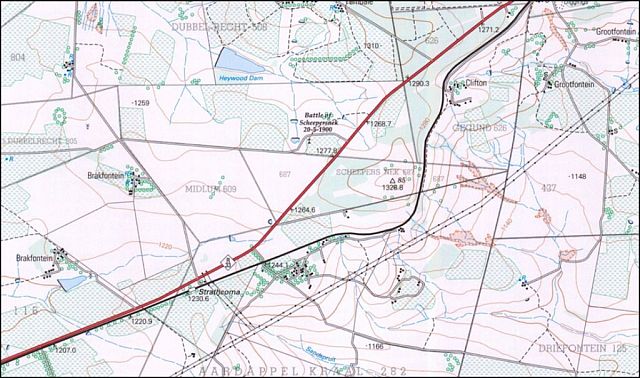
The original brass plaque on the monument, containing the names of those killed in action and one who died of his wounds, had come loose. The Commonwealth War Graves Comission accordingly removed it to their store ·for satekeeping. This plaque is a magnificent piece of work and contains the names of those killed in the action (bar yet another who died of wounds) and who lie buried on either side of the Pyramid cairn. A new black-granite replica of the plaque has been made and fitted. Being made of polished granite, it is unlikely to suffer damage or theft. The original brass plaque will be donated to the Talana Museum in Dundee where it will be on permanent display.

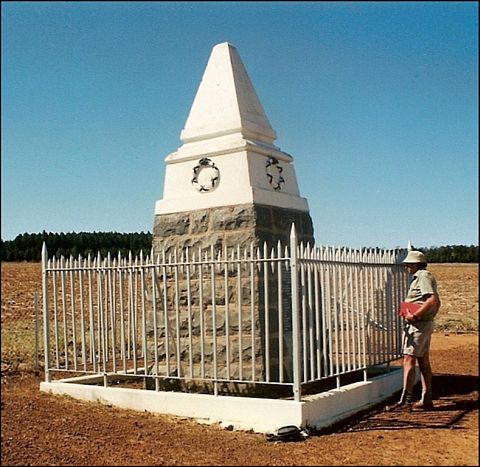
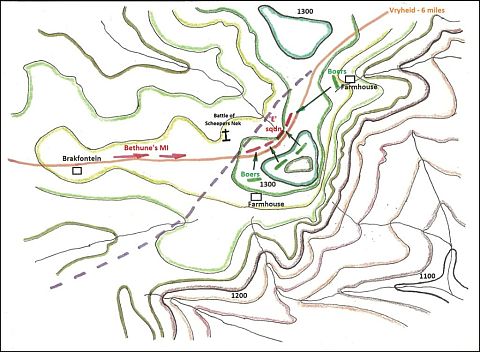
Bethune's Mounted Infantry was one of a number of irregular mounted units raised in the Colony of Natal when war was declared in October 1899. Major E C Bethune of the 16th Lancers, an officer in South Africa on special service, undertook to raise the regiment of 500 mounted men. He was given command and promoted to the rank of lieutenant colonel. In Natal, the BMI formed part of the Composite Brigade of Mounted Infantry with the Natal Carbineers, a squadron of the Imperial Light Horse and Thorneycroft's Mounted Infantry, another irregular regiment. They were present with Gene!al Redvers Buller's army in the campaign to lift the siege of Ladysmith.
Major General Lord Dundonald, commanding officer of the brigade, was favourably impressed with Bethune and his men, and said of them (Dundonald, 1926, p117) that 'Colonel Bethune, with Bethune's Mounted Infantry, now did the scouting, and well and rapidly was his work done.' This was when Dundonald took his brigade around Thabanyama, west of Spionkop, in an attempt to outflank the Boer defences on 18 January 1900. On 11 February Bethune's MI were sent to Greytown. They formed part of a small force including the local Greytown volunteer regiment, the Umvoti Mounted Rifles and the Natal Artillery . Command of this force was given to Lieutenant Colonel Bethune. They were to watch the Boers near the Zululand border and thus missed the fighting that resulted in the relief of Ladysmith (Stirling, pp 63-4).
Once Buller's army started its march towards the Transvaal border, Bethune's MI advanced from Greytown northwards towards Helpmekaar. Buller's plan was to outflank the Boers and advance along the Biggarsberg from Helpmekaar towards Newcastle and Laing's Nek. By 11 May, Buller had crossed the Waschbank River and bivouacked at Vermaak's Kraal. On the following day the attack up the Uithoek Pass towards the small village of Helpmekaar was made by Dundonald's mounted men. The Natal Volunteers took the hills to the west of the pass while Thorneycroft's MI went straight up the pass. They were somewhat surprised to find Bethune and his men already at the top, having come in from the west in the early morning (Williams, Vol IV, 1906, pp 171-2; Dundonald, 1926, p 157).
The main body of the Boers retired northwards but a small number under Christiaan Botha moved back eastwards towards their homes around Vryheid: Still watching Buller's right flank, Bethune's detached command was sent eastwards to Nqutu. No Boers were found there but the magistracy was re-established. The opportunity was taken to assemble the Zulu indunas from around the area and to thank them for the restraint that they had exercised and for the patient attitude they had maintained during the many months that the Boers had occupied their country (De la Warr, 1900, p 115).
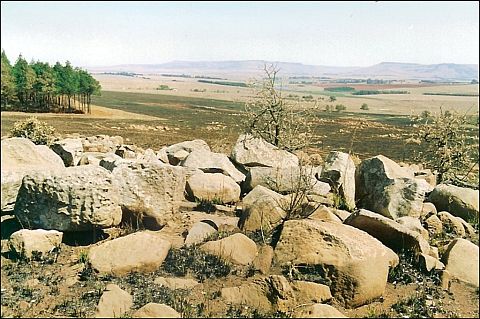
Bethune's orders were to march to Newcastle but intelligence was gained from local Africans near Blood River who reported that we might find a few Boers, forty or fifty perhaps, just outside Vryheid ... ' (De la Warr, 1900, p 116). The BMI's intelligence officer, Lt L W Lanham, resident for many years in the Transvaal, was leading the scouts. Bethune's orders were for Captain William Goff and 'E' Squadron to advance cautiously to Vryheid, keeping well to the rear of the scouts and giving them ample time to reconnoiter. Goff, a promising young officer of the 3rd Dragoon Guards, had only recently joined the BMI. His own regiment only arrived in South Africa in February 1901 but he was one of a number of British regular officers who were sent to South Africa on special service (Hall, 1999, p 72).
The scouts were given their orders and left Blood River at 15h00 followed by Goff leading 'E' Squadron and followed by Captain Ford and 'D' Squadron at ten minute intervals. De la Warr, accompanying Colonel Bethune, described (1900, p117) how 'we had to ride hard to keep up with the leading squadrons'. Goff and his men were 'nearing a hollow when six Boers came forward, firing a few shots at them and then retiring.' This was a decoy and the British spurred forwards over the rise and into, a trap.
The road curved around a little hollow a short distance from where it breasted a rise between two pieces of high ground - Schieeper's Nek. To the right of the road was a rocky outcrop behind which the mainBoer force was sited. At farmhouses at either end of the hollow were more Boers. Goff's men were assailed from three sides and not a single man escaped unscathed. De la Warr gives the casualty count as 'thirty killed, twenty-eight wounded and thirteen prisoners', but the casualty list gjves considerably more than this. Ford's 'D' Squadron attempted a rescue but were driven back by heavy fire. As it was becoming dark, Bethune judged that it was prudent to withdraw and return to Nqutu. There is no record of even a single casualty on the Boer side although Ford's squadron opened fire and landed a few well-directed shots among the enemy' with two Hotchkiss guns (De la VVarr, 1900, p119).
The dead were buried by the Boers in a field a short distance from where the fight took place, the ground being softer there than the rocky ground along the road. The wounded who were their prisoners were taken into \/ryheid and were 'well cared for' while Bethune sent Archdeacon Johnson from St Augustine's Mission, near Rorke's Drift, to read the burial service over the graves (De la Warr 1900, p 120. He does not say when this was, but it is likely to have been several days later).
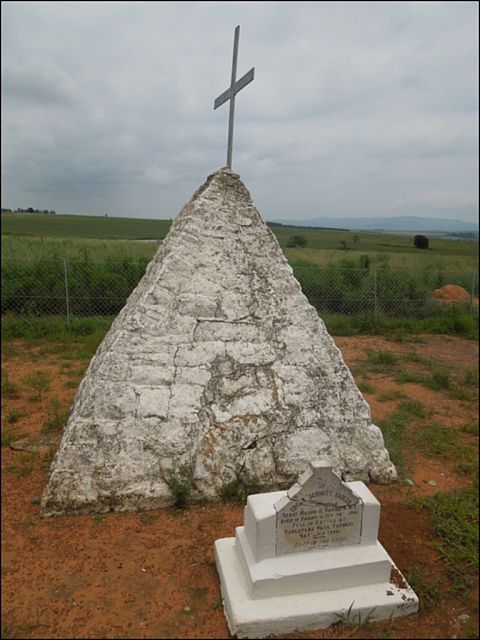
The BMI retired to Nqutu and made their way the following day to Newcastle. When Vryheid was occupied on 19 September, the BMI were involved in turning the strong Boer position. For the rest of the war the regiment was occupied in patrolling the south of the Transvaal and the Utrecht area. In one his dispatches, quoted in Stirling (p 65), Buller had "this to say about Colonel Bethune: 'Raised this regiment and commanded it most efficiently throughout the campaign.'
Postscript
In May 2013, the new granite plaque was affixed to the Scheeper's Neck monument. It is exactly the same size and design as the original brass plaque that it replaced except that the names on the regimental flag were too small to be reproduced.
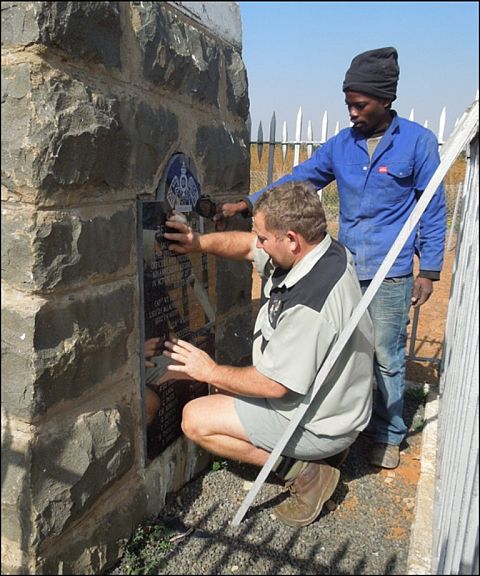


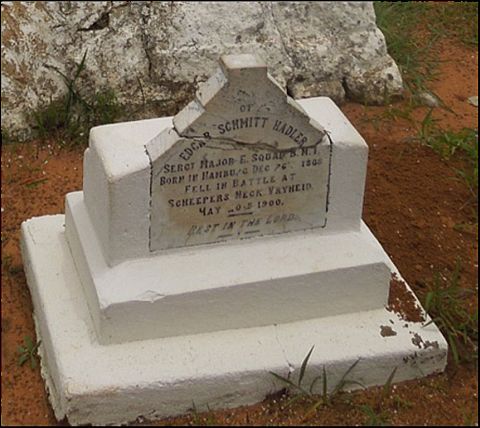
An additional monument has been erected within the enclosure to the three Hamilton brothers, all fatalities of the Anglo-Boer War. Ernest was killed in action at Scheeper's Nek, probably unaware that his brother Kenneth had died of enteric (typhoid fever) four days previously in Bloemfontein. A third brother, Alan, was struck by lightning and killed in December 1902 near Machadodorp in the eastern Transvaal (now Mpumalanga). The monument is an exact replica of the gravestone to Kenneth Hamilton, now badly damaged, that stands in the President Street military cemetery in Bloemfontein. (Steve Watt, In Memoriam, notes that the three Hamiltons were brothers. Gert and Erika van der Westhuizen, Guide to the Anglo Boer War in the Eastern Transvaal, has a picture of the grave of Alan Hamilton with an inscription that incorrectly proclaims it to be the mass grave of the three brothers.)
All from 'E' Squadron, Bethune's Mounted Infantry
Killed in action on 20 May 1900:
| Captain | WED | Goff |
| Lieutenant | L W | Lanham |
| Lieutenant | D F | McLachlan |
| S Sgt. Major | E S | Hadler |
| Sergeant | F W | Moon |
| Corporal | W A | Benson |
| Corporal | E H | Roberts |
| Trooper | J S | Beyers |
| Trooper | H S | Billing |
| Trooper | E | Coleman |
| Trooper | H | de Lorme |
| Trooper | W | Garfield |
| Trooper | M C | Gillies |
| Trooper | E | Hamilton |
| Trooper | C B | Hammond |
| Trooper | S | Ingham |
| Trooper | R S O | Ingle |
| Trooper | W F | Johnstone |
| Trooper | J | Lang |
| Trooper | G | Paige |
| Trooper | P J H | Rudderforth |
| Trooper | D | Seaton |
| Trooper | A | Stanley |
| Trooper | T | Stansby |
| Trooper | BD | Stone |
| Trooper | H | Thompson |
| Trooper | R H | Tuckwell |
| Trooper | E | Udell |
| Trooper | S | Watson |
Died of wounds:
(both are buried in the town cemetery, Vryheid):
Sgt Farrier J Cock. (Died 28 May 1900)
Trooper L A Cowie (Died 6 June 1900)*
* Cowie's name appears on the plaque on the monument at Scheeper's Nek.
Wounded:
A further 45 men were listed as wounded.
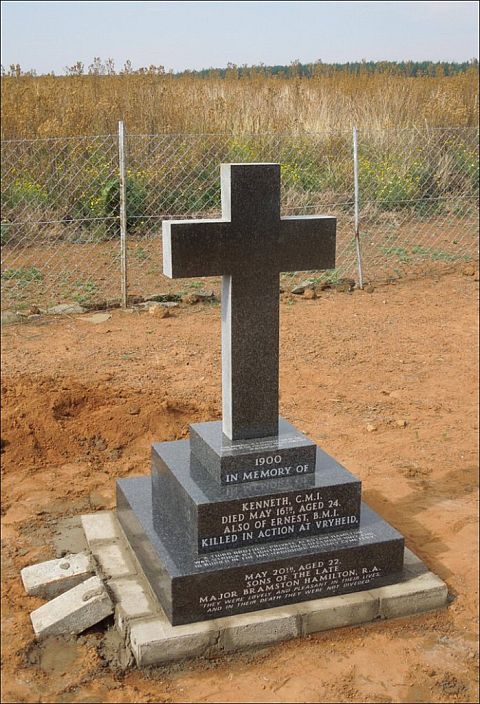

BIBLIOGRAPHY
Chilvers, Hedley (ed), The Times History of the War in South Africa, Volume V (Sampson Low, Marston and Company, Ltd, London, 1907).
De la Warr, the Earl, Some reminiscences of the war in South Africa (Hurst and Blackett, Limited, 13, Great Marlborough Street, London, 1900)
Dooner, Mildred G, The Last Post (J B Hayward & Son, Polstead, Suffolk, 1980, reprint of edition of 1903).
Dundonald, the Earl of, My Army Life (Edward Arnold & Co, London, 1926).
Hall, Darrell, The Hall Handbook of the Anglo-Boer War (University of Natal Press, Pietermaritzburg, 1999) .
Maurice, Major General Sir Frederick, History of the war in South Africa, Volume 4 (Hurst and Blackett Limited, London, 1910).
Stirling, John, The Colonials in South Africa 1899-1902 (William Blackwood & Sons, Edinburgh & London, 1907, reprint by J B Hayward & Son, Polstead, Suffolk).
Van der Westhuizen, Gert & Erika, Guide to the Anglo-Boer War in the Eastern Transvaal (Gert & Erika van der Westhuizen, Volksrust, 2000).
Watt, Steve, In Memoriam (University of Natal Press, Pietermaritzburg, 2000)
Williams, Basil (ed), The Times History of the War in South Africa, Volume IV (Sampson Low, Marston and Company, Ltd, London, 1906).
Wilson, H W, With the Flag to Pretoria, Volume II (London, 1903).
Return to Journal Index OR Society's Home page
South African Military History Society / scribe@samilitaryhistory.org